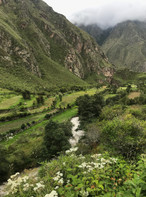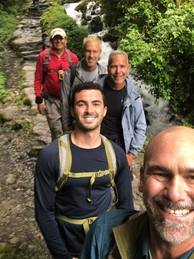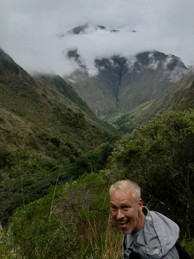Robert: After 3 years of living out of a suitcase meeting new people on a daily basis, I was having my Garbo moment alone in Treme. It was 1986, I worked in the Quarter as a framer’s assistant and most lunches were spent sitting in Jackson Square watching people feed the pigeons. I remember once sitting on a bench and within minutes I had company - one of those open-faced people who just invite you in no matter how hard you try to be left alone. He pulled out a copy of Pablo Neruda’s poems - The Heights of Machu Picchu and read the English translation and the original Spanish with such animation I was mesmerised. He had walked El Camino Inca and by the end of that lunch break I had in my hands a gift from a complete stranger- that copy of Neruda’s classic. I still have it on a shelf in Sydney. I vowed I’d one day complete the trail. I wish I remembered his name.
Erik: I probably didn’t really learn of Machu Picchu until the 90s, cemented by Robert telling me about The Heights of Machu Picchu. We had always talked about going one day and until we started planning our trip, I didn’t really think about how we would get there. With my research and planning hat on, it was pretty clear we needed to challenge ourselves on the Inca Trail before we were too old to do it. Also, for a place so special, it seemed a waste to take the bus to the site, see it for a couple of hours and leave. I wanted to spend time in the presence of the civilisation as a lead-up to arriving at Machu Picchu.
The 2 of us

And just like that we were on the trail. After a 6am pick up and transfer by van, the trail starts at Piskacucho km 82. Our 10 porters carried the gear in backpacks weighing over 20 kilos each while we walked along with our tiny day packs – talk about delicate flowers. This was a 4-day / 3-night trip organised through the Peruvian owned tour agency Condor Travel. Our tour guide Miguel has been experiencing Machu Picchu all his life starting as an 11-year-old schoolboy playing soccer on one of the fields during a class trip, to leading El Camino Inca walks for 25+ years. Our first day was a test. We acclimated to the trail grade, the damp steep rocks, the slight rain and our group. We were 15 strangers who would share a unique experience of a lifetime -- at least for 4 of us.
Our trekking partners were a father and son from Dallas, Texas. Chris and Joe were easy to get to know and shared some of the same reasons for being on the walk. We became fast friends. Luckily Joe was willing to walk at our 50+ year old pace since his dad Chris landed right in our age group. That’s a fairly fit 50+ pace ;-). Breathing was heavy, legs were feeling it, but the Andes made it all worthwhile – amazingly beautiful. At times we were alone on the trail which seems impossible with 200 trekkers and 300 porters allowed on this adventure each day. We had our first intro to the Inca ruins, a site called Llaqtapata, where Miguel explained its structure and the significance of the various levels. The lowest level runs along the river in the shape of a snake with the temple looking like its head – just the beginning of the incredible architectural accomplishments of this culture. Our first campsite in Huayllabamba was on a small farm complete with mules, chooks, a crowing rooster and bubbling brook – the soundtrack for the trek. The porters had us all set-up on arrival including warm water for our aching feet. This was incredible. Day one – tick! We had been trekking at an altitude of almost 3,000 meters above sea level (masl) over 12 km and completed it in a little over 5 hours.
Once Day 2 started, we quickly realised that Day 1 was a walk in the park. We would be climbing 1000 meters in several hours, from our campsite up to Warmiwanusca, commonly known as Dead Woman’s Pass. The name comes from the shape of the mountains that look like a reclined woman with a big breast, rather than any actual deaths, but that name was intimidating. Along the way, we also encountered the “Gringo Killer” steps. Now there were two places to kill us. Taking a breath continued to challenge as we ascended. While the climb up was gruelling, the climb down was a knee-and-calf wrecker. When we finally arrived into camp, we were greeted by rounds of applause from our porters and glasses of chicha-morada, a sweet purple corn juice which hit the spot. This camp site was overlooking a valley and had our trek soundtrack in stereo: a running rapid on one side and a gentler stream on the other. It was perfect – even if the dreaded drop toilets were finally introduced. This was billed as the hardest day and it delivered, but we made it. The sense of accomplishment and the beauty we experienced was euphoric – and we don’t use that word lightly. Could have been aided a bit by the coca tea.
Like the previous morning, on Day 3 we had a 5AM wake-up call initiated with a cup of coca tea to get us going and help with the altitude. With ridiculously stiff legs and cotton-padded blisters, we set out on our way. The third day is the longest at 16km, but the altitudes were not as high so it is considered an “easier” trek. While the hike was long, the experiences along the way made it the most special day. We trekked through a number of different Inca sites, including Runkurayqay and Sayaqmarka, descended into the jungle and were introduced to all of the amazing flora that line the trail. There was an OMG moment when we realised we weren’t just hiking on a single layer of stones, but on entire stone walls that bridged mountain sides. Incredible engineering – and how did it get built without modern equipment!
The rains came around mid-day which made for a very unhappy Erik, but fortunately only lasted for 45 minutes. Considering we were hiking at the end of the rainy season, we were pretty lucky that this was the only real rainy period for the entire climb. And by the time we reached camp at Winaywayna, we had mostly dried out.
As this was our last night in camp, we were treated like royalty by the porters and ended the meal with a homemade cake to celebrate. It’s still unbelievable how they carry gear for three meals a day along with cooking supplies including a gas bottle, our tents, our clothes and even a supplementary toilet. The food prepared for us was unbelievable, considering it all had to be carried up the mountain. Over the course of the three days, we had grilled trout, lomo saltado (a Peruvian classic), asparagus soup, mushroom soup, quinoa soup, pancakes, omelettes, and an amazing, must-recreate mushroom ceviche along with snacks for the trek. I think we both put on weight even with the calories burned.
3 AM. That was the wake-up time for Day 4 which allowed us to get in the check point line by 4:15. They introduced a check point here as non-ticketed trekkers used to make their way to Machu Picchu in the middle of the night to be the first there. While waiting, we heard a story of two Australian streakers who were found doing a nudie run at sunrise through the site. Could just be folklore but entertaining all the same. Go the Aussies! At 5:30, we were ushered through the check point and began our walk to the Sun Gate, complete with beautiful, in-the-clouds-valley-views along the way as the skies lightened. At the Sun Gate, we were rewarded with the actual sun peeking through low clouds – stunning! And after three days of full cloud cover an unexpected surprise. The few clouds burned off, giving us full glimpses of the city of Machu Picchu below. This is it – breathtaking! worth every breath.
Feeling pretty chuffed, we started our final hour-long walk down to the ruins. Once there, we made a run for the bathrooms with flushing toilets – what a luxury! This is the real tourist experience. After a quick coffee-break, Miguel started our tour of the ancient city. There is much to be said about Machu Picchu which we will not reiterate here as it is covered fairly well in Wikipedia. For a more in-depth read, our guide mentioned the book written by Inca Garcilosa de la Vega called the Comentarios Reales de las Incas. Peruvians believe this is a more accurate account of the Inca empire, rather than the history as written by Hiram Bingham, the American who “rediscovered” the site in 1911.
We wandered freely throughout this sacred site, marvelled at the engineering and continued to question what would have become of this ancient culture if they had not been conquered by the Spanish. Pictures don’t do it justice; words can’t express emotionally what you may experience on this trek. This was an experience of a lifetime – breathtaking.
























































































































































































The Inca Trail is one of the most important hiking routes in South America located in Peru - Cusco. This is influenced by its original Inca architecture, the archaeological remains along the way and the natural mix of jungle and cloud forest along the way, The duration is 4D / 3N, it is undoubtedly one of the best roads traveled and only authorized agencies can operate this magnificent route.
https://www.crossoverperu.org/
https://www.crossoverperu.org/inca-trail-treks/inca-trail-trek-4d-3n
Fantastic pictures and lovely words. Keep posting Gentlemen.
BBeautifully told. What an adventure.